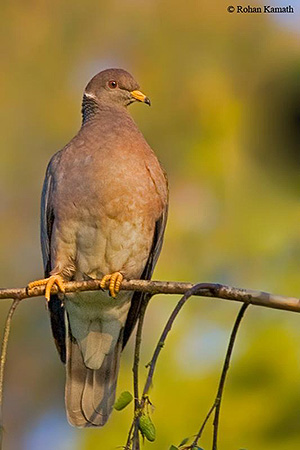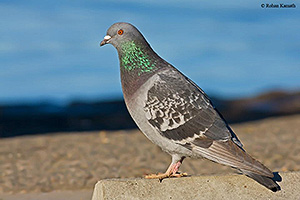Bird Milk |
|
|---|---|

  photographs of Band-tailed Pigeon, Rock Dove and Mourning Dove by Rohan Kamath |
Like
mammals, the young of some birds are fed on special
secretions from a parent. Unlike mammals, however, both
sexes produce it. The best known of these secretions is the
"crop milk" that pigeons feed to squabs. The milk is
produced by a sloughing of fluid-filled cells from the
lining of the crop, a thin-walled, sac-like food-storage
chamber that projects outward from the bottom of the
esophagus. Crops are presumably a device for permitting
birds to gather and store food rapidly, minimizing the time
that they are exposed to predators. Crops tend to be
especially well developed in pigeons and game
birds. Crop milk is extremely nutritious. In one study, domestic chicks given feed containing pigeon crop milk were 16 percent heavier at the end of the experiment than chicks that did not receive the supplement. The pigeon milk, which contains more protein and fat than does cow or human milk, is the exclusive food of the nestlings for several days after hatching, and both adults feed it to the squabs for more than two weeks. The young pigeons are not fed insects as are the chicks of many seed-eating birds; instead, the crop milk provides the critical ration of protein. The milk of Greater Flamingos contains much more fat and much less protein than does pigeon milk, and its production is not localized in a crop, but involves glands lining the entire upper digestive tract. Interestingly, the milk contains an abundance of red and white blood cells, which can be seen under the microscope migrating like amoebas through the surface of the glands. Young flamingos feed exclusively on this milk for about two months, while the special filter-feeding apparatus that they will later employ for foraging develops. Emperor Penguin chicks may also be fed milk in some circumstances. Each male incubates a single egg on his feet, covered with a fold of abdominal skin, for two months of the Antarctic winter, fasting while the female is out at sea feeding. If the female has not returned with food by the time the chick hatches, the male feeds it for a few days on milk secreted by the esophagus. After its brief diet of milk, the chick will be fed by regurgitation alternately by the male and female as they travel one at a time to the sea to hunt. |
| Thus three very different groups of birds have evolved the capacity to produce milk as solutions to very different problems: the need for protein and fat in the pigeons, which feed very little animal material to the squabs; the need for liquid food consumption during the development of the specialized feeding apparatus of the flamingos (which would make any other form of food difficult for the chicks to ingest); and the need for a convenient food supplement when breeding on the barren Antarctic ice shelf favored by penguins. | |
| SEE:
Flamingo Feeding;
Brood Patches;
Urban Birds. Copyright ® 1988 by Paul R. Ehrlich, David S. Dobkin, and Darryl Wheye. |
|